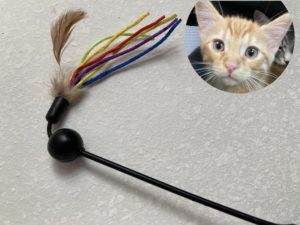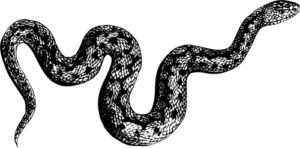The other day, a kitten came into the clinic for his 4 month exam and vaccines. He was a ball of energy and wanted to climb up me so I took out a toy from one of the cabinet drawers to play with him. This toy was a small wand with bells and feathers on it. I whisked the trailing feathers on the floor by him.
Poor fellow – the toy must have startled and scared him – he puffed up and hissed. I put the toy on the floor for him to examine – he approached tentatively, smelled the feathers and hissed again, so I put the toy away.
Later, when the doctor came into to do his examination, I pulled the toy out of the cabinet to show her; the kitten saw it and hissed again.

Why do cats hiss? What does it mean?
Domestic cats are capable of making at least 21 discrete vocalizations; our cats use these sounds to communicate with us – each cat has his/her own repertoire of sounds to tell us what he/she wants or feels.
How the hiss is made
The hiss is a long forceful exhalation made with the mouth open and the teeth bared. A hiss is a hiss – hisses among cats sound similar – it is a “voiceless” communication. The hiss can be made in a number of situations – we must look to the context and body language to interpret it.
When do cats hiss?
- when they are afraid: Although we may associate hissing with anger and aggression, cats are more likely to hiss when they are afraid; it is usually the defensive cat who hisses in the cat fight. When accompanied by the fur standing on end, dilated pupils, and a cringing posture, the message is “I am afraid; leave me alone. I will defend myself if I have to.”
- when they are startled – the “fight or flight” response is triggered; fur may be standing on end while the cat assesses the situation – is there danger?
- when they are in pain – a hiss might mean don’t touch my “ouchy” spot – it hurts!
- when they are frustrated/displeased – a cat may hiss when things are not going his way. My cat, Gus, will hiss when waiting for dinner (if service is slow!) or when another cat gets in his way. These hisses tend to be short and are not accompanied by fur on end, dilated pupils or change in posture.
Other thoughts on why cats hiss

- Some experts think that cats hiss to mimic a snake and scare off attackers. Early mammals evolved in a landscape dominated by reptiles, which could be deadly. Evolutionarily, the hiss is coupled with fear for many mammals. Perhaps, cats are taking advantage of this connection of the hiss with fear.
- While we may hush a baby to soothe it or shush someone to keep them quiet, your cat may not interpret these sounds the same way. Instead, shhh and hush may sound like a hiss to her, perhaps triggering a fearful/anxious response.
Back to our kitten friend, his initial hiss with his fur puffed up was due to being startled, with the accompanying rush of adrenalin as he did not know if this toy was dangerous.
When the kitten smelled the toy, he hissed again but without fear (no puffy fur) – perhaps he could smell other cats on this toy and this made him a little anxious (are these other cats who played with this toy friendly?)
He hissed again on seeing the toy from across the exam room, letting us know he did NOT like that toy!
In the video below, Gus and Marley are waiting for treats. Gus swats Marley and then gives a long hiss. His body posture is not tense, although he turns to the side to look more threatening; his fur is not puffed up. He is warning Marley to keep his distance (“and don’t even think of going for my treats!”)
Humans may curse or swear when they are annoyed, startled, excited, or in pain – cats, on the other hand, hiss. The hiss tells us the cat is experiencing a negative emotion. Before handling him, look to his body language to see if he is afraid, reacting to a painful stimulus or merely annoyed.


